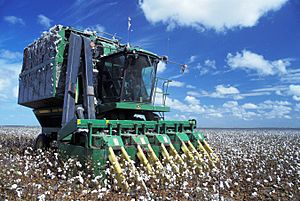Mechanized agriculture facts for kids

Mechanised agriculture means using machines to do farm work. It's like giving farmers superpowers! These machines help farmers grow more food and do their jobs much faster. In the past, people and animals like oxen, horses, and mules did most farm tasks. Now, powerful machines have taken over many of these jobs.
People have always used tools in farming, like hoes and ploughs. But since the Industrial Revolution (a time when many new machines were invented), farming has changed a lot. Machines have made farming much easier and less about hard physical work.
Today, mechanised agriculture uses many different vehicles and tools. These include tractors, trucks, and huge machines called combine harvesters. Farmers even use aeroplanes and helicopters to spray crops from the sky! Modern farming also uses computers, satellite imagery, and satellite navigation (like GPS) to help grow even more food. This is called Precision agriculture.
Using machines in farming helped many people move from farms to cities. It also made countries more industrial. Machines not only help farmers produce more food, but they can also make the food better. However, there are some challenges. Machines can mean fewer jobs for farm workers who don't have special skills. They can also sometimes harm the environment if not used carefully. This can lead to pollution, cutting down too many trees (deforestation), or dirt washing away (soil erosion).
Contents
The History of Farm Machines
For thousands of years, farming was done by hand or with simple tools. People used hoes to dig and ploughs pulled by animals to prepare the soil. This was very hard work and took a lot of time.
The Start of Modern Machines
The big change began with the Industrial Revolution in the 1700s and 1800s. New inventions like the steam engine meant machines could be powered by something other than people or animals.
- Early machines like the reaper helped cut crops faster.
- Threshing machines separated grain from the plant.
- These early machines were often pulled by horses or powered by steam engines.
Tractors Change Everything
The invention of the tractor was a huge step forward. Early tractors ran on steam or gasoline. They were strong enough to pull ploughs and other tools across large fields. This meant farmers could work much more land than before.
- Tractors made farming faster and more efficient.
- They replaced many horses and human workers.
- Over time, tractors became more powerful and had many different attachments.
How Machines Help Farmers Today
Modern farm machines are amazing! They can do many different jobs, from planting tiny seeds to harvesting huge fields of crops.
Planting and Preparing Fields
Before planting, farmers need to prepare the soil.
- Ploughs turn over the soil, making it ready for seeds.
- Cultivators break up clumps of dirt and remove weeds.
- Planters put seeds into the ground at just the right depth and spacing. Some can plant many rows at once!
Growing and Protecting Crops
Once crops start to grow, machines help keep them healthy.
- Sprayers apply water, fertilisers (food for plants), or pesticides (to keep bugs away).
- Some large farms use aeroplanes or helicopters for "aerial application" to spray huge areas quickly.
Harvesting Crops
Harvesting is when farmers collect their crops. This used to be a very long and difficult job.
- The combine harvester is one of the most important farm machines. It can cut, thresh, and clean grain all in one go!
- For other crops like cotton or potatoes, there are special harvesting machines.
- Balers collect hay or straw and press it into large, easy-to-move bales.
Smart Farming with Technology
Today, farming is getting even smarter with technology.
- GPS guidance helps tractors drive in perfectly straight lines, saving fuel and making sure no part of the field is missed.
- Sensors can check the soil's health or how much water plants need.
- Drones can fly over fields to check on crops from above.
- Computers help farmers decide exactly where to plant, how much fertiliser to use, and when to harvest. This is called Precision agriculture. It helps farmers use resources wisely and grow more food.
Benefits of Mechanised Agriculture
Using machines in farming has many good points.
- More Food: Machines help farmers grow much more food than they could by hand. This is important for feeding the world's growing population.
- Faster Work: Tasks that used to take days or weeks can now be done in hours.
- Less Hard Work: Farmers don't have to do as much heavy lifting or tiring work.
- Bigger Farms: Machines make it possible to farm very large areas of land.
- Better Quality: Sometimes, machines can harvest crops more gently or efficiently, leading to better quality food.
Challenges of Mechanised Agriculture
While machines are great, there are also some things to think about.
- Cost: Farm machines can be very expensive to buy and maintain.
- Jobs: Machines can do the work of many people, which means fewer jobs for farm workers who don't have special skills.
- Environment: If not used carefully, heavy machines can compact the soil, making it harder for plants to grow. They can also use a lot of fuel, which can cause pollution. Sometimes, farming practices can lead to soil erosion or deforestation.
- Skills: Farmers need to learn how to operate and fix complex machines.
Overall, mechanised agriculture has changed farming forever. It helps us produce the food we need, but it's important to use these powerful tools wisely and sustainably.
Images for kids
-
A reaper at Woolbrook, New South Wales
-
Threshing machine in 1881. Steam engines were also used to power threshing machines. Today both reaping and threshing are done with a combine harvester.






